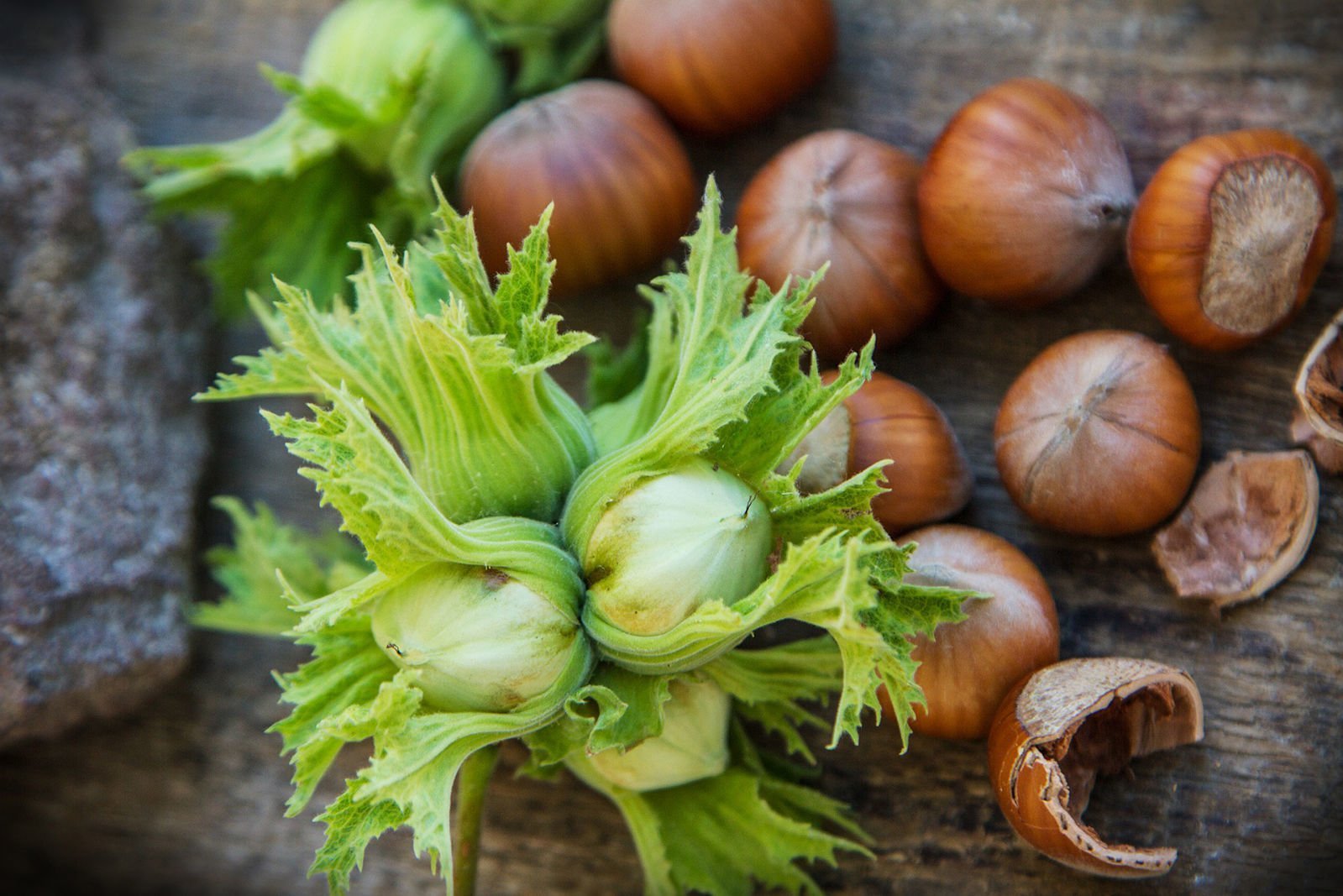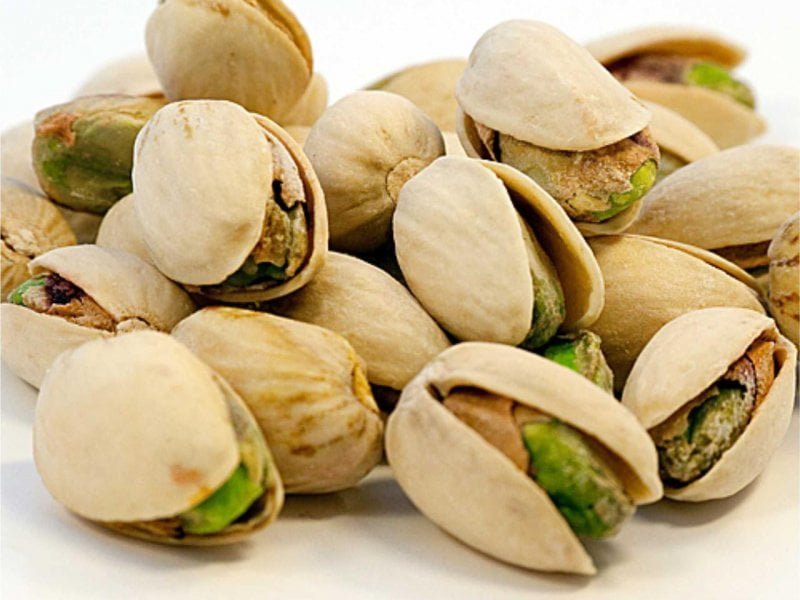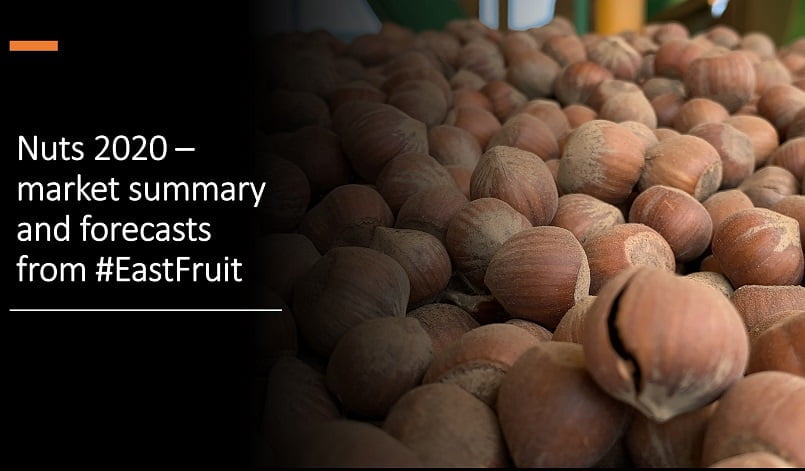The nut business in 2020 feared significant losses due to the coronavirus, as nuts are expensive and do not belong to essential products. However, in general, the fears of a decrease in consumption volumes did not materialise. Although, of course, there were some severe problems, which we will talk about in this final material. Also, EastFruit analysts will try to assess the prospects for the development of the nut business in 2021, emphasising Ukraine, Moldova, Georgia, Uzbekistan and Tajikistan.

Walnut
Let’s start with the essential nut crop for the region, which is undoubtedly the walnut. At the beginning of the pandemic in the spring of 2020, demand for walnuts fell sharply but gradually recovered. Overall, though, prices were lower than manufacturers expected. Perhaps, the main reason was not covid19, but the growth of world production of walnuts.
The world’s largest importers of walnuts Germany, Italy, the United Arab Emirates, Spain, Mexico, Turkey and Japan, mainly increased their imports. Germany in the first nine months of 2020 increased imports by 41%, Japan by 22%, Spain by 16% and Mexico by 6%. Only Italy has slightly reduced imports of walnuts.
Turkey bought almost the same volume of walnuts as a year earlier. Still, the country changed its vector of supplies, sharply increasing walnuts imports from the United States and reducing purchases from Ukraine by almost three times. Germany and other major importers have also boosted their imports of US nuts. Germany has more than quadrupled its imports of American walnuts! Moldova also took advantage of the growth in walnuts imports to Germany and increased its supplies to this country.
The largest increase in purchases of walnuts by Turkey was from China. Earlier, Turkey almost did not import walnuts from China, but in 2020, the country bought more walnuts from China than from Ukraine. Therefore, one should not be surprised at the problems with the sale of walnuts from Ukraine and Moldova – after all, the United States exerted tremendous pressure on the world market, squeezing out competitors from the most attractive markets. As a result, both Moldova and Ukraine focused on exporting to those EU countries where they were already present. Nevertheless, Ukraine reduced its revenue from walnut exports in 10 months of 2020 by a quarter, although the export tonnage increased.
This year, Moldova appeared in the fruit and vegetable business news mainly with the word “drought”. Naturally, the walnut market also suffered, the yield and quality decreased.
Georgia was one of the leading newsmakers of the region’s nut business. Interestingly, Georgia has already planted more than 3,000 hectares of walnuts within the framework of the “Plant the Future” state support program!
Chandler walnut variety is the gold standard in the United States. Therefore many post-Soviet countries are actively planting it. The Chandler variety occupies almost all industrial walnut orchards in Uzbekistan and Georgia. In Moldova, there are also many areas under this variety, and even in Ukraine, many large enterprises plant hundreds of hectares of Chandler walnut.
Therefore, the news that in Georgia, this variety did not justify itself and did not give the desired results were shocking. However, Doctor of Agricultural Science Zviad Bobokashvili hastened to reassure everyone, explaining the reasons for the failures and proposing real solutions to the Chandler plantations’ problems in Georgia.
Many also liked our video from the largest Georgian walnut growing farm with 100% of the plantations under the Chandler variety. The video showed how American walnut harvesting equipment works, how walnuts are cleaned, dried, refined, and processed.

While Georgia is rapidly expanding the area under walnuts, the country’s entrepreneurs understand that without drying, cleaning and other processing, the walnut industry will not produce the desired result. Therefore, the country is already witnessing a boom in the construction of enterprises for processing walnuts.
Who knows, perhaps one day the exports of walnuts will eventually generate more revenue for Georgia than famous Georgian wines’ exports?
What does 2021 have in store for us? Will global demand for walnuts grow?
“It is clear that walnut acreage is growing in most countries around the world, even in the United States, which is already the clear market leader. It means that if we do not consider the periodic fluctuations in production due to climatic cataclysms, one should expect an increase in production at a rate that outstrips the growth in consumption over the next decade. Therefore, the efficiency of growing walnuts and their quality parameters will come to the fore. Poor quality walnuts will become increasingly difficult to sell, and this is a wake-up call for Ukraine and Moldova, which continue to export, as a rule, non-varietal walnuts,” says Andriy Yarmak, an economist at the Investment department of the UN Food and Agriculture Organization (FAO).
In conclusion, here are the most-read articles on walnuts on the EastFruit portal in 2020:
- Four varieties of low-growing and early-harvested nuts are already in the State Register of Varieties of Ukraine.
- Ivanhoe walnut variety is a competitor of the long-term market leader Chandler walnut.
- Top-3 most promising walnut varieties for Moldova.
In 2020, among the most popular videos on our Youtube channel, there were several videos about walnuts: “A seven-year-old Chandler walnut orchard in California“, “How to get 3 tons of walnuts per hectare in the third year after planting” and “Harvesting Chandler walnuts in a large modern orchard with drying and processing Agrovia GE“.
Almonds
The main news of the year on the almond market was the collapse of world prices due to a sharp increase in production. The USA and Spain had unprecedented almond harvests. Other countries were also actively increasing their production of almonds. Thanks to lower prices, almonds’ global consumption is expected to rise sharply, which is good news.
Investors in Georgia are actively expanding the area under almonds. There are already farms managing thousands of hectares of almond orchards. In particular, Adjara Group will expand the area under its almond orchards to an incredible 5,000 hectares!
The organic almond segment is also actively developing. The opinion of a foreign investor in almond orchards that Georgia will be the new California of world almond production aroused great interest. There are already superintensive almond orchards in Georgia, and, according to producers, they allow to get much higher yields of almonds per hectare.
Azerbaijan is not lagging behind Georgia: they are also actively planting almond orchards and are already starting to construct the largest almond processing enterprise. For example, the company AZBADAM has 500 hectares of almond orchards and is ready to help others bring almonds to marketable condition.
Despite the high weather risks, Ukraine is also actively trying to enter the growing almond business, planting locally bred almond orchards because the USA or Spain experience is not relevant here. By the way, neighbouring Moldova is also actively developing the cultivation of almonds. According to various estimates, this country has already planted more than 2,600 hectares of almond orchards.
Considering that the USA is a monopolist on the global almond market, it is not surprising that our detailed article on the technologies of growing, harvesting and processing almonds in California, USA, was trendy in 2020. Many people also watched the video on the technology and economics of growing and marketing Almonds in California on our Youtube channel.

But the region that is perfect for growing almonds – Central Asia, particularly Uzbekistan and Tajikistan, the countries included in the EastFruit region – so far show a low level of activity in this segment. Here, almonds and pistachios are considered forest crops and many do not know about the possibility of their cultivation in commercial plantings.
Considering the sharp drop in world prices for almonds, investor interest in this nut may slightly decrease. Nevertheless, production will continue to grow, given the large areas of young plantations around the world. It means that the almond market situation will be the same as in the walnut market: efficiency and quality will come to the fore.
Hazelnut
Unlike walnuts, almonds and pistachios, the world market for hazelnuts is not controlled by the United States. Here, the undoubted long-term leader is Turkey, which in 2019 received the highest harvest of hazelnuts in history. Italy also has vast areas under hazelnuts, but it consumes them in record volumes; therefore, Italy is one of the major importers.
In 2020, the main news was the loss of hazelnuts harvests in the two largest producing countries: in Turkey because of rains and other weather calamities, and in Italy because of frosts. Therefore, world prices for hazelnuts, in contrast to walnuts and almonds prices, were very favourable. By the way, the United States and Chile are also actively increasing their areas under almonds. EastFruit wrote an exclusive article on the forecast of the world hazelnut market.
Many in the nut business do not know that Azerbaijan is the second-largest exporter of hazelnuts in the world after Turkey. The main reason is that Russia traditionally bought the main export volume of Azerbaijani hazelnuts. However, recently, Azerbaijan has begun to increase hazelnuts’ exports to the EU, and Italy and Germany buy more and more hazelnuts from Azerbaijan. Therefore, EastFruit’s exclusive article on the situation and prospects for developing the hazelnut business in Azerbaijan aroused a lot of interest.

Georgia, which has been reducing hazelnuts’ exports for several years in a row due to the massive damage the marble bug has inflicted on the industry, seems to be starting to restore production and export volumes. By the end of 2020, the volume of exports of Georgian hazelnuts of the new crop in monetary terms amounted to $70.7 million and was 43.7% higher than a year ago ($49.2 million).
Ukraine is also actively expanding the area under hazelnuts, although it is mainly the suppliers of seedlings that make money. It is difficult to say whether the country will be an exporter of hazelnuts. Nevertheless, hazelnuts are consistently included in the rating of the most popular crops for the establishment of perennial plantings in Ukraine. The article about the experience of growing hazelnuts in Croatia in relation to the conditions of Ukraine was among the top articles of the year 2020.
Moldova was also actively interested in hazelnuts. There were already more than 1,000 hectares of hazelnuts here. Therefore, articles on the prospects for growing hazelnuts in Moldova were also among the most read.
Even Belarus is already growing hazelnuts – the article about this case also fascinated our readers in 2020.
In general, the global hazelnut market in 2020 grew intensively – most of the leading countries increased both exports and imports. Therefore, interest in hazelnuts in the region will undoubtedly continue to grow.
Pistachio, macadamia, cashew
There is a high level of interest in pistachio in the EastFruit region. There is even a Pistachio Association in Georgia, and the country already planted its first orchards. Uzbekistan even announced plans to overtake the United States, Turkey and Iran in pistachio areas and is actively sharing its experience with Tajikistan, where pistachio is not yet industrially grown. There are already amateurs in Moldova and Ukraine who are trying to adapt pistachios to local growing conditions, but, of course, industrial pistachio cultivation is out of the question here.
Interestingly, the video “Pistachio cultivation technology in California” on our EastFruit Youtube channel continues to be the most popular of all, and the number of views is only growing.

The articles on macadamia nuts, the world trade of which is growing at a very high pace, also made it to the top at EastFruit portal. The macadamia nut is definitely popular with consumers, but it does not grow in this region. The situation is similar with the cashew nut: its sales are growing faster than other nuts, but we will not be able to grow it either.
Why are we writing about these nuts if they cannot be grown in the EEastFruit region? The point is that they are competing for the consumer’s wallets. If consumers buy more macadamia or cashews, they will buy fewer walnuts, hazelnuts, and almonds.
The use of the site materials is free if there is a direct and open for search engines hyperlink to a specific publication of the East-Fruit.com website.




